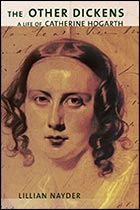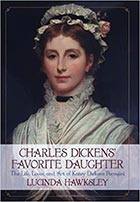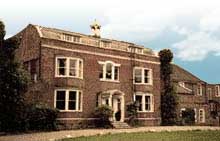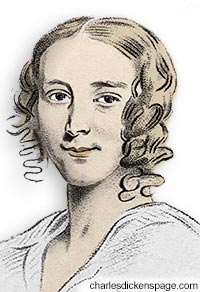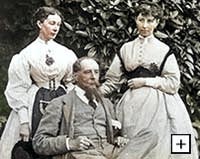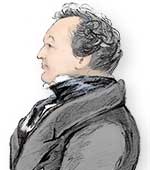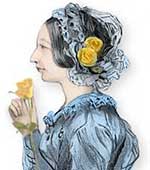Charles Dickens' Family
and FriendsLearn about Charles Dickens' parents, siblings, children, and more
Later Dickens' own family was marked by strife as his relationship with his wife deteriorated and his sons seemed to have inherited their paternal grandfather's trouble handling finances. Dickens once lamented that he had "brought up the largest family ever known, with the smallest disposition to do anything for themselves" (Letters, 1999, v. 11, p. 252). Dickens' extended family's constant drain on his finances, along with his built-in anxiety about money caused by his childhood, resulted in Dickens never feeling comfortable enough about his financial situation.
Dickens' circle of friends consisted of people prominent in the arts, journalism, publishing, politics and public life. A loyal friend who demanded loyalty in return, lines were drawn during Dickens' very public separation from Catherine. Those not sympathetic to Dickens' side soon felt his wrath, in some cases, forever (Nayder, 2011, p. 265-266).
Charles Dickens' Parents
John Dickens (1785-1851) - Dickens' father, was a clerk in the Navy Pay Office. In 1809 he married Elizabeth Barrow with whom he had eight children. John loved to live the good life but was frequently unable to pay for it. He was imprisoned for debt in 1824 in the Marshalsea Debtor's Prison. After his release from prison he returned to the Navy Pay Office, retired, and later worked as a reporter. His money problems continued and when Charles gained fame as a writer he frequently embarrassed his son by seeking loans from Charles' friends and publishers behind his back. Charles retained a warm affection for his father while deploring his inability to manage money (Schlicke, 1999, p. 169-173). John was the source of Charles' character Wilkins Micawber in the autobiographical novel, David Copperfield, as well as William Dorrit in Little Dorrit (Pugh, 1912, p. 339).
Elizabeth (Barrow) Dickens (1789-1863) - Dickens' mother, married John Dickens in 1809. Charles was the second of their eight children. Charles was taken from school to work at Warren's Blacking Factory to help support the family during John's imprisonment for debt. When John was released and a quarrel with Charles' employer resulted in Charles being removed from the blacking factory, his mother tried, unsuccessfully, to patch things up and have Charles return to work. For the rest of his life Charles never forgave her saying "I never afterwards forgot, I never shall forget, I never can forget, that my mother was warm for my being sent back" (Johnson, 1952, p. 44). Charles used his mother as the original for Mrs Nickleby in Nicholas Nickleby (Pugh, 1912, p. 185).
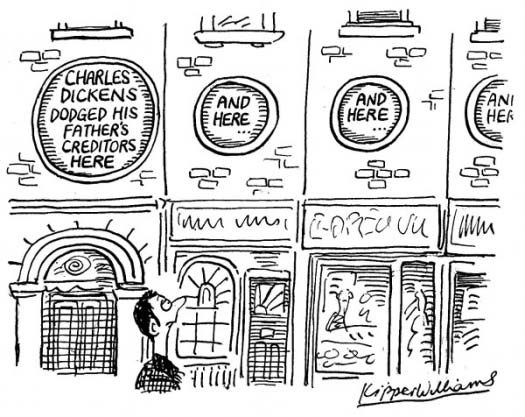
Cartoon copyright Kipper Williams and Fitzrovia News. Used with permission.
Charles Dickens' Siblings
Frances Elizabeth (Fanny) Dickens (August 1810-September 2, 1848) Dickens oldest sister with whom he was very close in childhood. She was a talented woman and studied music at the Royal Academy of Music. Fanny married Henry Burnett and had a crippled son, Henry Jr, whom Dickens used as a model for Paul Dombey and possibly Tiny Tim (Ackroyd, 1990, p. 519-520). Fanny died of consumption at age 38. See sidebar.
Read a letter Dickens wrote to his friend, John Forster, describing a visit to see his terminally ill sister.
Alfred Allen Dickens (March 28, 1814-September 1814) Dickens' younger brother who died in infancy (Slater, 2009, p. 5).
Letitia Mary Dickens (April 1816-1893) Dickens' younger sister, Letitia married architect and artist Henry Austin in 1837. When Henry died in 1862 Charles secured a government pension for Letitia (Davis, 1999, p. 104).
Harriet Dickens (1819-?) Dickens' sister who died in childhood (Davis, 1999, p. 104).
Frederick Dickens (August 1820-October 20, 1868) Dickens' younger brother who lived with Charles when he moved to Furnival's Inn in 1834 (Ackroyd, 1990, p. 161). Fred fell into debt, using Charles' name to obtain credit (Johnson, 1952, p. 452). Fred continued to hound his famous brother for money until finally Charles was forced to cut him off entirely (Johnson, 1952, p. 942-943). When he died at age 48 Charles lamented to John Forster that "It was a wasted life, but God forbid that one should be hard upon it, or upon anything in this world that is not deliberately and coldly wrong" (Forster, 1899, v. 2, p. 443)
Alfred Lamert Dickens (March 1822-July 1860) Dickens' younger brother, a civil engineer and sanitary inspector. When Alfred died in 1860 Charles helped support his family (Davis, 1999, p. 98).
Augustus Dickens (1827-October 4, 1866) Dickens' youngest brother. Dickens helped Augustus get a job with a wealthy merchant in London (Johnson, 1952, p. 494-495). Augustus' wife became blind and he left her and went to America with another woman with whom he lived as man and wife. He died at age 39 in Chicago and Charles gave support to both wives (Davis, 1999, p. 98). Augustus is buried in Graceland Cemetery in Chicago IL.
Charles Dickens' Wife Catherine
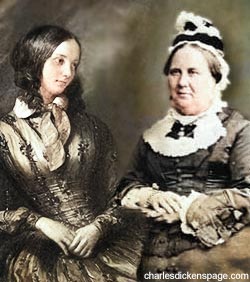
Catherine Dickens in the 1840s and in 1879
Read a letter from Dickens to John Forster concerning separation from Catherine.
Amazon.com: The Other Dickens: A Life of Catherine Hogarth by Lillian Nayder
Charles Dickens' Children
 Charles Culliford (Charley) Dickens (1837-1896) - Dickens' first child, educated at Eton, and studied business in Germany. Charley was the only child who lived with his mother after Dickens' separation with Catherine in 1858. In 1862 he married Bessie Evans, daughter of Dickens' former publisher, Frederick Evans, with whom Dickens had had a falling out. After a failed business venture, Dickens hired Charley as sub-editor of All the Year Round (Davis, 1999, p. 98).
Charles Culliford (Charley) Dickens (1837-1896) - Dickens' first child, educated at Eton, and studied business in Germany. Charley was the only child who lived with his mother after Dickens' separation with Catherine in 1858. In 1862 he married Bessie Evans, daughter of Dickens' former publisher, Frederick Evans, with whom Dickens had had a falling out. After a failed business venture, Dickens hired Charley as sub-editor of All the Year Round (Davis, 1999, p. 98).
 Mary (Mamie) Dickens (1838-1896) - Dickens' second child, named for Mary Hogarth. She never married and remained with Dickens until his death. She helped to edit her father's letters and published two books about her father: Charles Dickens By His Eldest Daughter (1885) and My Father as I Recall Him (1896) (Schlicke, 1999, p. 91).
Mary (Mamie) Dickens (1838-1896) - Dickens' second child, named for Mary Hogarth. She never married and remained with Dickens until his death. She helped to edit her father's letters and published two books about her father: Charles Dickens By His Eldest Daughter (1885) and My Father as I Recall Him (1896) (Schlicke, 1999, p. 91).
 Kate Macready (Katie) Dickens (1839-1929) Dickens' third child, named for Dickens' friend actor William Macready. She had a talent for art and attended Bedford college (Hawksley, 2013, p. 77-78). She sided with her mother in the separation of her parents and married artist Charles Collins, brother of Dickens' friend Wilkie Collins. She later admitted that she married to get away from what had become an unhappy home (Ackroyd, 1990, p. 874-877). When Collins, sickly for years, died she married artist Carlo Perugini. She later revealed her father's relationship with Ellen Ternan in Gladys Storey's book Dickens and Daughter (Schlicke, 1999, p. 91). In 1860 Katie posed for artist John Everett Millais' painting The Black Brunswicker. Katie's grave.
Kate Macready (Katie) Dickens (1839-1929) Dickens' third child, named for Dickens' friend actor William Macready. She had a talent for art and attended Bedford college (Hawksley, 2013, p. 77-78). She sided with her mother in the separation of her parents and married artist Charles Collins, brother of Dickens' friend Wilkie Collins. She later admitted that she married to get away from what had become an unhappy home (Ackroyd, 1990, p. 874-877). When Collins, sickly for years, died she married artist Carlo Perugini. She later revealed her father's relationship with Ellen Ternan in Gladys Storey's book Dickens and Daughter (Schlicke, 1999, p. 91). In 1860 Katie posed for artist John Everett Millais' painting The Black Brunswicker. Katie's grave.
Amazon.com: Charles Dickens' Favorite Daughter: The Life, Loves, and Art of Katey Dickens Perugini
 Walter Savage Landor Dickens (1841-1863) - Dickens' fourth child named for English poet Walter Savage Landor. He was nominated for a cadetship in the East India Company and went to India in 1857 (Johnson, 1952, p. 875-876). He distinguished himself at the mutiny at Calcutta and advanced to the rank of lieutenant in the 42nd Highlanders (Johnson, 1952, p. 954). He died of an aortic aneurysm in Calcutta (Ackroyd, 1990, p. 943). Having fallen deeply in debt while in India, his debts were sent home to his father (Davis, 1999, p. 105).
Walter Savage Landor Dickens (1841-1863) - Dickens' fourth child named for English poet Walter Savage Landor. He was nominated for a cadetship in the East India Company and went to India in 1857 (Johnson, 1952, p. 875-876). He distinguished himself at the mutiny at Calcutta and advanced to the rank of lieutenant in the 42nd Highlanders (Johnson, 1952, p. 954). He died of an aortic aneurysm in Calcutta (Ackroyd, 1990, p. 943). Having fallen deeply in debt while in India, his debts were sent home to his father (Davis, 1999, p. 105).
 Francis Jeffrey (Frank) Dickens (1844-1886) - Dickens' fifth child named for Dickens' friend Lord Francis Jeffrey, editor of the Edinburgh Review. He went to India in 1864 where he found his brother Walter had been dead a month. He joined the Bengal Mounted Police, returned to England in 1871, the year after his father's death. He squandered his inheritance and later went to Canada where he joined the Canadian Northwest Mounted Police. He died in Moline, Illinois (Schlicke, 1999, p. 91).
Francis Jeffrey (Frank) Dickens (1844-1886) - Dickens' fifth child named for Dickens' friend Lord Francis Jeffrey, editor of the Edinburgh Review. He went to India in 1864 where he found his brother Walter had been dead a month. He joined the Bengal Mounted Police, returned to England in 1871, the year after his father's death. He squandered his inheritance and later went to Canada where he joined the Canadian Northwest Mounted Police. He died in Moline, Illinois (Schlicke, 1999, p. 91).
 Alfred D'Orsay Tennyson Dickens (1845-1912) - Dickens' sixth child named for French artist Count Alfred D'Orsay and English poet Alfred Lord Tennyson. He emigrated to Australia in 1865 where he remained for 45 years. Later he lectured on his father's life and works in England and America, dying in New York on a lecture tour (Davis, 1999, p. 98).
Alfred D'Orsay Tennyson Dickens (1845-1912) - Dickens' sixth child named for French artist Count Alfred D'Orsay and English poet Alfred Lord Tennyson. He emigrated to Australia in 1865 where he remained for 45 years. Later he lectured on his father's life and works in England and America, dying in New York on a lecture tour (Davis, 1999, p. 98).
 Sydney Smith Haldimand Dickens (1847-1872) - Dickens' seventh child embarked on a career with the navy which pleased his father very much. He got into debt, asking his father for financial aid which Dickens finally refused. He died at sea aboard the Malta (Schlicke, 1999, p. 91).
Sydney Smith Haldimand Dickens (1847-1872) - Dickens' seventh child embarked on a career with the navy which pleased his father very much. He got into debt, asking his father for financial aid which Dickens finally refused. He died at sea aboard the Malta (Schlicke, 1999, p. 91).
 Henry Fielding (Harry) Dickens (1849-1933) - Dickens' eighth child named for English author Henry Fielding. Henry, educated at Cambridge, was the most successful of Dickens children (Ackroyd, 1990, p. 1033-1034). He became a lawyer, judge, and was knighted in 1922. Later he performed readings of his father's works and published books on Dickens' life (Schlicke, 1999, p. 91).
Henry Fielding (Harry) Dickens (1849-1933) - Dickens' eighth child named for English author Henry Fielding. Henry, educated at Cambridge, was the most successful of Dickens children (Ackroyd, 1990, p. 1033-1034). He became a lawyer, judge, and was knighted in 1922. Later he performed readings of his father's works and published books on Dickens' life (Schlicke, 1999, p. 91).
Dora Annie Dickens (1850-1851) - Dickens' ninth child was born during the writing of David Copperfield and was named for David's wife (Slater, 2009, p. 312). A sickly child, she died at eight months old (Ackroyd, 1990, p. 627-628).
 Edward Bulwer Lytton (Plorn) Dickens (1852-1902) - Dickens' 10th child and named for English Novelist and Dickens' friend Edward Bulwer-Lytton. He joined his brother Alfred in Australia at 16 years of age (Ackroyd, 1990, p. 1032-1033). He became a Member of Parliament in New South Wales, never returning to England (Schlicke, 1999, p. 91). Plorn is the subject of a novel by Thomas Keneally, The Dickens Boy.
Edward Bulwer Lytton (Plorn) Dickens (1852-1902) - Dickens' 10th child and named for English Novelist and Dickens' friend Edward Bulwer-Lytton. He joined his brother Alfred in Australia at 16 years of age (Ackroyd, 1990, p. 1032-1033). He became a Member of Parliament in New South Wales, never returning to England (Schlicke, 1999, p. 91). Plorn is the subject of a novel by Thomas Keneally, The Dickens Boy.
Catherine Dickens' Sisters
Catherine Hogarth was one of ten children. Two of her sisters figure prominently in Dickens' life: Mary Hogarth (1819-1837) - Catherine's sister moved into the Dickens household in 1836, shortly after the marriage (Johnson, 1952, p. 130). At 17 she took ill after attending the theater and died suddenly in Dickens' arms. Dickens was shattered and took a ring from her finger which he wore the rest of his life (Slater, 2009, p. 100). She was the model for Little Nell in The Old Curiosity Shop and many others (Pugh, 1912, p. 68). Dickens wrote the epitaph which appears on her gravestone: "Young, beautiful, and good, God numbered her among his angels at the early age of seventeen" (Johnson, 1952, p. 197). Mary's grave.
Mary Hogarth (1819-1837) - Catherine's sister moved into the Dickens household in 1836, shortly after the marriage (Johnson, 1952, p. 130). At 17 she took ill after attending the theater and died suddenly in Dickens' arms. Dickens was shattered and took a ring from her finger which he wore the rest of his life (Slater, 2009, p. 100). She was the model for Little Nell in The Old Curiosity Shop and many others (Pugh, 1912, p. 68). Dickens wrote the epitaph which appears on her gravestone: "Young, beautiful, and good, God numbered her among his angels at the early age of seventeen" (Johnson, 1952, p. 197). Mary's grave.
 Georgina Hogarth (1827-1917) - Catherine's sister joined the Dickens home at age 15, helping to run the household and raise the children (Ackroyd, 1990, p. 337). She remained with Dickens after the breakup of his marriage in 1858 prompting scandalous rumors. After Dickens' death in 1870 she remained devoted to his children and worked to retain the integrity of Dickens' reputation (Schlicke, 1999, p. 270-272). Georgina's grave.
Georgina Hogarth (1827-1917) - Catherine's sister joined the Dickens home at age 15, helping to run the household and raise the children (Ackroyd, 1990, p. 337). She remained with Dickens after the breakup of his marriage in 1858 prompting scandalous rumors. After Dickens' death in 1870 she remained devoted to his children and worked to retain the integrity of Dickens' reputation (Schlicke, 1999, p. 270-272). Georgina's grave.
Charles Dickens' Friends and Associates
 William Harrison Ainsworth (1805-1882) English novelist (Rookwood, Jack Sheppard) and influence on young Dickens. Ainsworth brought Dickens into his literary circle that included Forster, Thackeray, and Carlyle (Schlicke, 1999, p. 6).
William Harrison Ainsworth (1805-1882) English novelist (Rookwood, Jack Sheppard) and influence on young Dickens. Ainsworth brought Dickens into his literary circle that included Forster, Thackeray, and Carlyle (Schlicke, 1999, p. 6).
 Hans Christian Andersen (1805-1875) Danish writer and author of Fairy Tales. Dickens and Andersen admired each others work. Andersen visited Dickens at Gads Hill in 1857 and overstayed his welcome (he was there for 5 weeks) after which the friendship waned. Dickens' daughter Kate later wrote that Andersen was "a bony bore and stayed on and on" (Slater, 2009, p. 429).
Hans Christian Andersen (1805-1875) Danish writer and author of Fairy Tales. Dickens and Andersen admired each others work. Andersen visited Dickens at Gads Hill in 1857 and overstayed his welcome (he was there for 5 weeks) after which the friendship waned. Dickens' daughter Kate later wrote that Andersen was "a bony bore and stayed on and on" (Slater, 2009, p. 429).
 Maria Beadnell (1810-1886) Youngest daughter of a London banker. Dickens fell in love with Maria in 1829 and courted her unsuccessfully for 4 years as Maria's parents objected to the relationship (Slater, 2009, p. 33-39). In 1855 Maria, now Mrs Henry Winter, contacted Dickens and his infatuation with Maria was briefly rekindled...until they met and he saw that the matronly Mrs Winter was not the Maria of his imagination. Indeed, she "had become very fat! and quite commonplace" (Ackroyd, 1990, p. 724-729). Dickens based Dora Spenlow (David Copperfield) and Flora Finching (Little Dorrit) on Maria (Pugh, 1912, p. 43).
Maria Beadnell (1810-1886) Youngest daughter of a London banker. Dickens fell in love with Maria in 1829 and courted her unsuccessfully for 4 years as Maria's parents objected to the relationship (Slater, 2009, p. 33-39). In 1855 Maria, now Mrs Henry Winter, contacted Dickens and his infatuation with Maria was briefly rekindled...until they met and he saw that the matronly Mrs Winter was not the Maria of his imagination. Indeed, she "had become very fat! and quite commonplace" (Ackroyd, 1990, p. 724-729). Dickens based Dora Spenlow (David Copperfield) and Flora Finching (Little Dorrit) on Maria (Pugh, 1912, p. 43).
Thomas Beard (1807-1891) Journalist and Dickens' oldest friend. Dickens and Beard were reporters together at the Morning Chronicle and Beard was best man at Dickens wedding. Beard's younger brother Francis was Dickens' personal physician and was with him when he died (Davis, 1999, p. 23).
 Richard Bentley (1794-1871) Early Dickens publisher and owner of Bentley's Miscellany where Dickens published Oliver Twist and served as editor. Their stormy relationship ended in 1840 when Dickens bought out of his contract and purchased the rights to Oliver Twist (Schlicke, 1999, p. 35-38).
Richard Bentley (1794-1871) Early Dickens publisher and owner of Bentley's Miscellany where Dickens published Oliver Twist and served as editor. Their stormy relationship ended in 1840 when Dickens bought out of his contract and purchased the rights to Oliver Twist (Schlicke, 1999, p. 35-38).
 William Bradbury (1800-1869) Partner in Bradbury and Evans, Dickens' printers when he was published by Chapman and Hall, and then his publisher when he broke with Chapman and Hall in 1844. Dickens then broke with Bradbury and Evans in 1858 when they refused to print his explanation for the separation with Catherine in their magazine, Punch (Davis, 1999, p. 42).
William Bradbury (1800-1869) Partner in Bradbury and Evans, Dickens' printers when he was published by Chapman and Hall, and then his publisher when he broke with Chapman and Hall in 1844. Dickens then broke with Bradbury and Evans in 1858 when they refused to print his explanation for the separation with Catherine in their magazine, Punch (Davis, 1999, p. 42).
 Hablot Knight Browne (Phiz) (1815-1882) Dickens' major illustrator through most of his career. Browne took over the illustration of The Pickwick Papers after the suicide of Robert Seymour. Browne and Dickens developed an excellent working relationship and Browne took the nickname Phiz to complement Dickens' Boz. Browne would go on to illustrate Dickens' work for 24 years (Slater, 2009, p. 72). Dickens association with Browne cooled after the somewhat disappointing illustrations for A Tale of Two Cities. He never worked for Dickens again (Ackroyd, 1990, p. 941).
Hablot Knight Browne (Phiz) (1815-1882) Dickens' major illustrator through most of his career. Browne took over the illustration of The Pickwick Papers after the suicide of Robert Seymour. Browne and Dickens developed an excellent working relationship and Browne took the nickname Phiz to complement Dickens' Boz. Browne would go on to illustrate Dickens' work for 24 years (Slater, 2009, p. 72). Dickens association with Browne cooled after the somewhat disappointing illustrations for A Tale of Two Cities. He never worked for Dickens again (Ackroyd, 1990, p. 941).
 Edward Bulwer-Lytton (1803-1873) English novelist and playwright (Paul Clifford-It was a dark and stormy night...(Schlicke, 1999, p. 63)) who, with Dickens, founded the Guild of Literature and Art (Slater, 2009, p. 319-320). It was Bulwer-Lytton who persuaded Dickens to change the ending of Great Expectations from one where Pip and Estella part, to one where they apparently live happily ever after (Johnson, 1952, p. 968-969).
Edward Bulwer-Lytton (1803-1873) English novelist and playwright (Paul Clifford-It was a dark and stormy night...(Schlicke, 1999, p. 63)) who, with Dickens, founded the Guild of Literature and Art (Slater, 2009, p. 319-320). It was Bulwer-Lytton who persuaded Dickens to change the ending of Great Expectations from one where Pip and Estella part, to one where they apparently live happily ever after (Johnson, 1952, p. 968-969).
 Angela Burdett-Coutts (1814-1906) Wealthy philanthropist for whom Dickens helped to find suitable charitable projects such as Urania Cottage, a home for homeless women (Ackroyd, 1990, p. 494), and support for the Field Lane Ragged School, which provided education to the very poor (Ackroyd, 1990, p. 404-405).
Angela Burdett-Coutts (1814-1906) Wealthy philanthropist for whom Dickens helped to find suitable charitable projects such as Urania Cottage, a home for homeless women (Ackroyd, 1990, p. 494), and support for the Field Lane Ragged School, which provided education to the very poor (Ackroyd, 1990, p. 404-405).
 Thomas Carlyle (1795-1881) Scottish novelist and historian (History of the French Revolution), and a major influence, and close friend of Dickens. Dickens used Carlyle's work on the French Revolution as background for A Tale of Two Cities (Goldberg, 1972, p. 101).
Thomas Carlyle (1795-1881) Scottish novelist and historian (History of the French Revolution), and a major influence, and close friend of Dickens. Dickens used Carlyle's work on the French Revolution as background for A Tale of Two Cities (Goldberg, 1972, p. 101).
 Edward Chapman (1804-1880) Partner in Dickens publisher Chapman and Hall. Chapman was the more literary of the partners and it was he who originated the idea to issue The Pickwick Papers in monthly parts, a method which Dickens used throughout his career and contributed to his success (Schlicke, 1999, p. 70).
Edward Chapman (1804-1880) Partner in Dickens publisher Chapman and Hall. Chapman was the more literary of the partners and it was he who originated the idea to issue The Pickwick Papers in monthly parts, a method which Dickens used throughout his career and contributed to his success (Schlicke, 1999, p. 70).
 Frederic Chapman (1823-1895) Cousin of Edward Chapman with whom he partnered after the death of William Hall in 1847. He took over the business when Edward retired in 1866. After Dickens' death in 1870 Chapman secured the copyrights to all of Dickens' works (Schlicke, 1999, p. 73-74).
Frederic Chapman (1823-1895) Cousin of Edward Chapman with whom he partnered after the death of William Hall in 1847. He took over the business when Edward retired in 1866. After Dickens' death in 1870 Chapman secured the copyrights to all of Dickens' works (Schlicke, 1999, p. 73-74).
 Wilkie Collins (1824-1889) English novelist and journalist whom Dickens met in 1851. Collins' two most successful novels The Woman in White and The Moonstone were serialized in Dickens' weekly magazine All the Year Round. Dickens and Collins became fast friends, literary collaborators (The Lazy Tour of Two Idle Apprentices), and traveling companions (Italy, Paris) (Davis, 1999, p. 74-75). Collin's sickly brother, Charles, married Dickens' daughter Kate (Johnson, 1952, p. 960-961).
Wilkie Collins (1824-1889) English novelist and journalist whom Dickens met in 1851. Collins' two most successful novels The Woman in White and The Moonstone were serialized in Dickens' weekly magazine All the Year Round. Dickens and Collins became fast friends, literary collaborators (The Lazy Tour of Two Idle Apprentices), and traveling companions (Italy, Paris) (Davis, 1999, p. 74-75). Collin's sickly brother, Charles, married Dickens' daughter Kate (Johnson, 1952, p. 960-961).
 George Cruikshank (1792-1878) Popular illustrator who became an early friend of Dickens, illustrating Sketches by Boz and Oliver Twist (Davis, 1999, p. 81-82). Cruikshank also acted in Dickens' amateur theatrical company (Ackroyd, 1990, p. 532). Their friendship cooled when Cruikshank, formerly a heavy drinker, became a fanatical teetotaler in opposition to Dickens' views of moderation (Patten, 1992, p. 228-229). Cruikshank later claimed that the idea for Oliver Twist had been his (Forster, 1899, v. 2, p. 31-32).
George Cruikshank (1792-1878) Popular illustrator who became an early friend of Dickens, illustrating Sketches by Boz and Oliver Twist (Davis, 1999, p. 81-82). Cruikshank also acted in Dickens' amateur theatrical company (Ackroyd, 1990, p. 532). Their friendship cooled when Cruikshank, formerly a heavy drinker, became a fanatical teetotaler in opposition to Dickens' views of moderation (Patten, 1992, p. 228-229). Cruikshank later claimed that the idea for Oliver Twist had been his (Forster, 1899, v. 2, p. 31-32).
 George Dolby (-1900) Manager of Dickens' reading tours in England and America from 1866-1870. Dickens loved Dolby's ability to take charge and get things done and the two became close friends. In 1885 he recorded his memories of touring with Dickens in Charles Dickens as I Knew Him. Dolby died in a paupers' hospital in 1900 (Schlicke, 1999, p. 180-182). Dolby also managed a reading tour of England for Mark Twain (Ackroyd, 1990, p. 977).
George Dolby (-1900) Manager of Dickens' reading tours in England and America from 1866-1870. Dickens loved Dolby's ability to take charge and get things done and the two became close friends. In 1885 he recorded his memories of touring with Dickens in Charles Dickens as I Knew Him. Dolby died in a paupers' hospital in 1900 (Schlicke, 1999, p. 180-182). Dolby also managed a reading tour of England for Mark Twain (Ackroyd, 1990, p. 977).
 Augustus Egg (1816-1863) Artist and actor in Dickens theatricals for which he also designed costumes (Johnson, 1952, p. 729). He proposed to Dickens' sister-in-law, Georgina, which she refused (Johnson, 1952, p. 918). He travelled to France, Switzerland, and Italy with Dickens and Wilkie Collins in 1853 (Johnson, 1952, p. 785-786).
Augustus Egg (1816-1863) Artist and actor in Dickens theatricals for which he also designed costumes (Johnson, 1952, p. 729). He proposed to Dickens' sister-in-law, Georgina, which she refused (Johnson, 1952, p. 918). He travelled to France, Switzerland, and Italy with Dickens and Wilkie Collins in 1853 (Johnson, 1952, p. 785-786).
 George Eliot (1819-1880) English novelist (Adam Bede, Silas Marner, Middlemarch) born Mary Anne Evans, the daughter of a Warwickshire carpenter. Mary Anne wrote fiction under the name George Eliot and lived for more than 20 years with author George Henry Lewes (1817-1878) while Lewes was still married to another woman. Lewes was an old friend of Dickens and had been a member of Dickens' amateur theatrical troupe (Hughes, 1999, p. 140-141). Dickens enjoyed Eliot's first fiction, Scenes of Clerical Life, recognizing immediately that it was written by a woman (Hughes, 1999, p. 189). Dickens approached Eliot for a piece for his weekly, All the Year Round, in 1859 which Eliot had to decline due to other obligations (Hughes, 1999, p. 211). Both Eliot and Lewes were physically unattractive and Dickens privately referred to them as "the ugliest couple in London" (Ackroyd, 1990, p. 266).
George Eliot (1819-1880) English novelist (Adam Bede, Silas Marner, Middlemarch) born Mary Anne Evans, the daughter of a Warwickshire carpenter. Mary Anne wrote fiction under the name George Eliot and lived for more than 20 years with author George Henry Lewes (1817-1878) while Lewes was still married to another woman. Lewes was an old friend of Dickens and had been a member of Dickens' amateur theatrical troupe (Hughes, 1999, p. 140-141). Dickens enjoyed Eliot's first fiction, Scenes of Clerical Life, recognizing immediately that it was written by a woman (Hughes, 1999, p. 189). Dickens approached Eliot for a piece for his weekly, All the Year Round, in 1859 which Eliot had to decline due to other obligations (Hughes, 1999, p. 211). Both Eliot and Lewes were physically unattractive and Dickens privately referred to them as "the ugliest couple in London" (Ackroyd, 1990, p. 266).
 Frederick Mullet Evans Partner in the firm of Bradbury and Evans, publishers of Dickens' works from 1844-1858. When the firm refused to print a statement by Dickens concerning his separation with Catherine, the angry Dickens broke with the firm and went back to his original publishers, Chapman and Hall. When Dickens' son Charles married Evans' daughter Bessie in 1862, Dickens refused to attend the wedding (Ackroyd, 1990, p. 825).
Frederick Mullet Evans Partner in the firm of Bradbury and Evans, publishers of Dickens' works from 1844-1858. When the firm refused to print a statement by Dickens concerning his separation with Catherine, the angry Dickens broke with the firm and went back to his original publishers, Chapman and Hall. When Dickens' son Charles married Evans' daughter Bessie in 1862, Dickens refused to attend the wedding (Ackroyd, 1990, p. 825).
 John Forster (1812-1876) An accomplished journalist, biographer, and historian, Forster was Dickens' best friend, literary advisor, and biographer. Forster proof-read nearly all of Dickens' works in progress. A man of great common sense, Forster provided the frequently impetuous Dickens sound personal, literary, and business advise. Dickens relied heavily on Forster to take care of business during his frequent trips away from London. Forster was also one of the players in Dickens' amateur acting troupe.
John Forster (1812-1876) An accomplished journalist, biographer, and historian, Forster was Dickens' best friend, literary advisor, and biographer. Forster proof-read nearly all of Dickens' works in progress. A man of great common sense, Forster provided the frequently impetuous Dickens sound personal, literary, and business advise. Dickens relied heavily on Forster to take care of business during his frequent trips away from London. Forster was also one of the players in Dickens' amateur acting troupe.
Forster was drama critic and later editor of the Examiner, putting him in the center of London literary life. After Dickens' death in 1870, Forster published The Life of Charles Dickens, drawn heavily on hundreds of letters from Dickens through the years and still the definitive Dickens biography although some facts about Dickens' life were suppressed. Forster also wrote biographies of Goldsmith, Defoe, and Swift among others (Schlicke, 1999, p. 236-240).
 Elizabeth Gaskell (1810-1865) Dickens was so impressed with Gaskell's novel Mary Barton that she was one of the first authors he solicited to contribute to his weekly magazine HouseHold Words. She became a regular contributor to the magazine. She disapproved of the way Dickens handled his separation with Catherine but continued to contribute to Dickens next weekly, All the Year Round. Dickens visited Gaskell and her husband on trips to Manchester (Davis, 1999, p. 146).
Elizabeth Gaskell (1810-1865) Dickens was so impressed with Gaskell's novel Mary Barton that she was one of the first authors he solicited to contribute to his weekly magazine HouseHold Words. She became a regular contributor to the magazine. She disapproved of the way Dickens handled his separation with Catherine but continued to contribute to Dickens next weekly, All the Year Round. Dickens visited Gaskell and her husband on trips to Manchester (Davis, 1999, p. 146).
William Hall (1801-1847) Partner in the firm of Chapman and Hall, publisher of Dickens' works from 1840-1844 and from 1858-1870. Hall was the business expert in the firm, his partner, Edward Chapman, was the literary expert (Ackroyd, 1990, p. 176-177).
 George Hogarth (1783-1870) Dickens' father-in-law, educated in the law at Edinburgh, he once served as legal Advisor to Sir Walter Scott (Slater, 2009, p. 47). He met Dickens in 1834 when they worked together at the Morning Chronicle. Hogarth later edited the Evening Chronicle for which Dickens contributed articles (Ackroyd, 1990, p. 162). Dickens married his daughter Catherine in 1836.
George Hogarth (1783-1870) Dickens' father-in-law, educated in the law at Edinburgh, he once served as legal Advisor to Sir Walter Scott (Slater, 2009, p. 47). He met Dickens in 1834 when they worked together at the Morning Chronicle. Hogarth later edited the Evening Chronicle for which Dickens contributed articles (Ackroyd, 1990, p. 162). Dickens married his daughter Catherine in 1836.
 Washington Irving (1783-1859) First American author to gain worldwide recognition. Dickens was an admirer and his description of Christmas was compared to Irving's (Johnson, 1952, p. 167). They met during Dickens' 1842 trip to America where Irving supported Dickens' views on international copyright (Davis, 1999, p. 189). The relationship cooled with the publication of Dickens' American Notes, which was critical of America (Ackroyd, 1990, p. 351).
Washington Irving (1783-1859) First American author to gain worldwide recognition. Dickens was an admirer and his description of Christmas was compared to Irving's (Johnson, 1952, p. 167). They met during Dickens' 1842 trip to America where Irving supported Dickens' views on international copyright (Davis, 1999, p. 189). The relationship cooled with the publication of Dickens' American Notes, which was critical of America (Ackroyd, 1990, p. 351).
 John Leech (1817-1864) Illustrator for the satirical magazine Punch, and for Dickens' Christmas books (A Christmas Carol). On the death of Dickens' illustrator Robert Seymour in 1836, Leech unsuccessfully applied to illustrate The Pickwick Papers. Also an actor in Dickens' amateur theatricals (Schlicke, 1999, p. 322-325).
John Leech (1817-1864) Illustrator for the satirical magazine Punch, and for Dickens' Christmas books (A Christmas Carol). On the death of Dickens' illustrator Robert Seymour in 1836, Leech unsuccessfully applied to illustrate The Pickwick Papers. Also an actor in Dickens' amateur theatricals (Schlicke, 1999, p. 322-325).
 Mark Lemon (1809-1870) Editor of the satirical magazine Punch. Lemon contributed articles to Dickens' weekly Household Words and adapted several Dickens' stories for the stage. Dickens and Lemon's friendship was another victim of Dickens' separation from Catherine, the two did not speak from 1858 to 1864 when they were reconciled at the graveside of mutual friend Clarkson Stanfield (Schlicke, 1999, p. 326-327).
Mark Lemon (1809-1870) Editor of the satirical magazine Punch. Lemon contributed articles to Dickens' weekly Household Words and adapted several Dickens' stories for the stage. Dickens and Lemon's friendship was another victim of Dickens' separation from Catherine, the two did not speak from 1858 to 1864 when they were reconciled at the graveside of mutual friend Clarkson Stanfield (Schlicke, 1999, p. 326-327).
 Henry Wadsworth Longfellow (1807-1882) American poet and professor of modern languages at Harvard. Dickens met Longfellow during his first American visit in 1842 and the two became fast friends. Longfellow visited Dickens in London later in 1842 and stayed at Dickens' home at Devonshire Terrace, Dickens took Longfellow on a tour of the London slums. Longfellow visited Dickens in England again in 1856 and 1868 (Davis, 1999, p. 219).
Henry Wadsworth Longfellow (1807-1882) American poet and professor of modern languages at Harvard. Dickens met Longfellow during his first American visit in 1842 and the two became fast friends. Longfellow visited Dickens in London later in 1842 and stayed at Dickens' home at Devonshire Terrace, Dickens took Longfellow on a tour of the London slums. Longfellow visited Dickens in England again in 1856 and 1868 (Davis, 1999, p. 219).
 Daniel Maclise (1806-1870) Artist and close friend of Dickens early in his career. He painted several pictures of the Dickens family including the famous Nickleby Portrait, painted in 1839 (Johnson, 1952, p. 259-260). Maclise also provided illustrations for The Old Curiosity Shop and several of Dickens' Christmas Books. Maclise Painting: Merry Christmas at the Baron's Hall-1838.
Daniel Maclise (1806-1870) Artist and close friend of Dickens early in his career. He painted several pictures of the Dickens family including the famous Nickleby Portrait, painted in 1839 (Johnson, 1952, p. 259-260). Maclise also provided illustrations for The Old Curiosity Shop and several of Dickens' Christmas Books. Maclise Painting: Merry Christmas at the Baron's Hall-1838.
 William Macready (1793-1873) Distinguished actor and manager of the Covent Garden theater. An intimate friend of the Dickens family, Macready took responsibility for Dickens' children when he and Catherine went to America in 1842 (Johnson, 1952, p. 358). Dickens dedicated his most theatrical novel, Nicholas Nickleby, to Macready (Ackroyd, 1990, p. 283).
William Macready (1793-1873) Distinguished actor and manager of the Covent Garden theater. An intimate friend of the Dickens family, Macready took responsibility for Dickens' children when he and Catherine went to America in 1842 (Johnson, 1952, p. 358). Dickens dedicated his most theatrical novel, Nicholas Nickleby, to Macready (Ackroyd, 1990, p. 283).
John Macrone (1809-1837) Dickens first publisher (Sketches by Boz) (Ackroyd, 1990, p. 174). After Dickens' fame skyrocketed be was able to buy out his agreements with Macrone (Johnson, 1952, p. 208-209). Macrone died unexpectedly at age 28 and Dickens helped to publish a book (Pic-Nic Papers) to benefit Macrone's widow and children (Johnson, 1952, p. 258).
 Edgar Allan Poe (1809-1849) American writer and poet best known for The Raven, The Tell-Tale Heart, The Pit and the Pendulum, and Annabel Lee. Poe praised Dickens' The Old Curiosity Shop in a review for Graham's Magazine. Poe and Dickens met twice in Philadelphia during Dickens' stay there. Poe asked Dickens for help finding him a British publisher. Dickens did try but was unsuccessful and the relationship cooled (Slater, 2009, p. 184). It is generally accepted that Dickens' pet raven, Grip, was the inspiration for Poe's poem, The Raven (Davis, 1999, p. 321).
Edgar Allan Poe (1809-1849) American writer and poet best known for The Raven, The Tell-Tale Heart, The Pit and the Pendulum, and Annabel Lee. Poe praised Dickens' The Old Curiosity Shop in a review for Graham's Magazine. Poe and Dickens met twice in Philadelphia during Dickens' stay there. Poe asked Dickens for help finding him a British publisher. Dickens did try but was unsuccessful and the relationship cooled (Slater, 2009, p. 184). It is generally accepted that Dickens' pet raven, Grip, was the inspiration for Poe's poem, The Raven (Davis, 1999, p. 321).
Dickens and Poe in Philadelphia - Herb Moskovitz
 Clarkson Stanfield (1793-1867) English landscape and marine painter (The Abandoned) and friend of Dickens from 1838. Stanfield painted background scenery for Dickens' amateur theatricals (Ackroyd, 1990, p. 742)and contributed illustrations for the Christmas books (Battle of Life, The Haunted Man). Stanfield, a Catholic, was invited to illustrate Pictures from Italy but declined due to Dickens satirical treatment of Catholicism in the book (Ackroyd, 1990, p. 491-492). Dickens dedicated Little Dorrit to Stanfield.
Clarkson Stanfield (1793-1867) English landscape and marine painter (The Abandoned) and friend of Dickens from 1838. Stanfield painted background scenery for Dickens' amateur theatricals (Ackroyd, 1990, p. 742)and contributed illustrations for the Christmas books (Battle of Life, The Haunted Man). Stanfield, a Catholic, was invited to illustrate Pictures from Italy but declined due to Dickens satirical treatment of Catholicism in the book (Ackroyd, 1990, p. 491-492). Dickens dedicated Little Dorrit to Stanfield.
 Frank Stone (1800-1859) Illustrator and, from 1851 to 1860, a neighbor of the Dickens family. Stone contributed illustrations to several of Dickens' works (The Haunted Man, later editions of Nicholas Nickleby and Martin Chuzzlewit) and was an actor in Dickens' amateur theatricals (Davis, 1999, p. 367).
Frank Stone (1800-1859) Illustrator and, from 1851 to 1860, a neighbor of the Dickens family. Stone contributed illustrations to several of Dickens' works (The Haunted Man, later editions of Nicholas Nickleby and Martin Chuzzlewit) and was an actor in Dickens' amateur theatricals (Davis, 1999, p. 367).
 Marcus Stone (1840-1921) Illustrator and artist, son of artist Frank Stone. After the death of his father in 1859, Dickens became like a second father to Marcus. Dickens employed the young artist to illustrate the Library Edition of Great Expectations and the monthly parts of Our Mutual Friend. Marcus later abandoned illustration to pursue painting (Schlicke, 1999, p. 540).
Marcus Stone (1840-1921) Illustrator and artist, son of artist Frank Stone. After the death of his father in 1859, Dickens became like a second father to Marcus. Dickens employed the young artist to illustrate the Library Edition of Great Expectations and the monthly parts of Our Mutual Friend. Marcus later abandoned illustration to pursue painting (Schlicke, 1999, p. 540).
 Sir Thomas Noon Talfourd (1795-1854) Lawyer, author, and Member of Parliament. Talfourd befriended the young Dickens and introduced him to his literary circle (Ackroyd, 1990, p. 211-212). He was an ardent supporter of Dickens' crusade for copyright protection (Slater, 2009, p. 187). Dickens dedicated The Pickwick Papers to Talfourd.
Sir Thomas Noon Talfourd (1795-1854) Lawyer, author, and Member of Parliament. Talfourd befriended the young Dickens and introduced him to his literary circle (Ackroyd, 1990, p. 211-212). He was an ardent supporter of Dickens' crusade for copyright protection (Slater, 2009, p. 187). Dickens dedicated The Pickwick Papers to Talfourd.
 Ellen Ternan (1839-1914) Dickens' mistress, an 18 year old actress that Dickens met in 1857 when he hired her, her mother, and sister to act in his production of The Frozen Deep (Tomalin, 1990, p. 73). Dickens continued a secret relationship with Ellen until his death and was not known to the public until 65 years later (Tomalin, 1990, p. 235-236). There is still much speculation about how intimate their relationship was (Davis, 1999, p. 384).
Ellen Ternan (1839-1914) Dickens' mistress, an 18 year old actress that Dickens met in 1857 when he hired her, her mother, and sister to act in his production of The Frozen Deep (Tomalin, 1990, p. 73). Dickens continued a secret relationship with Ellen until his death and was not known to the public until 65 years later (Tomalin, 1990, p. 235-236). There is still much speculation about how intimate their relationship was (Davis, 1999, p. 384).
The Mystery of Ellen Ternan
 William Makepeace Thackeray (1811-1863) English novelist (Vanity Fair, The Virginians). Dickens and Thackeray first met when illustrator Robert Seymour committed suicide during the serialization of The Pickwick Papers and a new illustrator was sought, Thackeray applied, unsuccessfully, for the job (Forster, 1899, v. 1, p. 71-72). Though never an intimate relationship, Dickens and Thackeray shared mutual admiration for each other's work. Thackeray was from a higher social strata than was Dickens and pointed this out on occasion. The two literary greats had a falling out over an incident at the Garrick Club in 1858 but were reconciled shortly before Thackeray's death (Schlicke, 1999, p. 559). Dickens eulogized Thackeray in Cornhill Magazine in February 1864.
William Makepeace Thackeray (1811-1863) English novelist (Vanity Fair, The Virginians). Dickens and Thackeray first met when illustrator Robert Seymour committed suicide during the serialization of The Pickwick Papers and a new illustrator was sought, Thackeray applied, unsuccessfully, for the job (Forster, 1899, v. 1, p. 71-72). Though never an intimate relationship, Dickens and Thackeray shared mutual admiration for each other's work. Thackeray was from a higher social strata than was Dickens and pointed this out on occasion. The two literary greats had a falling out over an incident at the Garrick Club in 1858 but were reconciled shortly before Thackeray's death (Schlicke, 1999, p. 559). Dickens eulogized Thackeray in Cornhill Magazine in February 1864.
 William Henry (Harry) Wills (1810-1880) Journalist (Penny Magazine, Punch) and editor (Monthly Magazine, The Daily News) whom Dickens worked with at The Daily News (Johnson, 1952, p. 577). Dickens hired Wills as sub-editor of Dickens' weekly magazine Household Words and later All the Year Round (Slater, 2009, p. 302). In this role Wills became indispensable to Dickens and the two became fast friends. Dickens' entrusted Wills with forwarding his letters to Ellen Ternan during Dickens' second American trip (Tomalin, 1990, p. 179-180). Wills suffered a concussion after being thrown by a horse in 1868 and was later forced to retire (Ackroyd, 1990, p. 1026-1027).
William Henry (Harry) Wills (1810-1880) Journalist (Penny Magazine, Punch) and editor (Monthly Magazine, The Daily News) whom Dickens worked with at The Daily News (Johnson, 1952, p. 577). Dickens hired Wills as sub-editor of Dickens' weekly magazine Household Words and later All the Year Round (Slater, 2009, p. 302). In this role Wills became indispensable to Dickens and the two became fast friends. Dickens' entrusted Wills with forwarding his letters to Ellen Ternan during Dickens' second American trip (Tomalin, 1990, p. 179-180). Wills suffered a concussion after being thrown by a horse in 1868 and was later forced to retire (Ackroyd, 1990, p. 1026-1027).

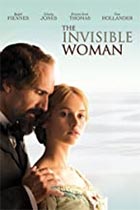 The Invisible Woman
The Invisible Woman